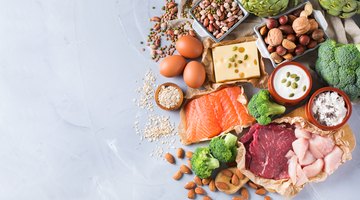How to Get Rid of Mother's Apron Belly
When your belly expands due to weight gain, the fat surrounding the internal organs expands, and creates additional fat deposits into the omentum -- an apron-like flap that lies under your abdominal muscles and in front of the intestines. A mother's apron belly isn't unique to women who've given birth.
Anyone -- man or woman -- can develop this hanging flap of fat that can only be addressed with focused diet and exercise. Losing it is critical to your health. Belly fat in the omentum and the rest of your mid-section increases your risk of heart disease, type 2 diabetes and, in women, certain cancers -- including ovarian cancer.
Prioritize Loss in an Apron Belly
Although spot-targeting fat loss isn't possible -- you can't crunch away an apron belly, for example -- fat that accumulates in your mid section is often the first you lose with focused exercise and diet. The same metabolically active properties that make apron fat -- also known as visceral fat -- a possible cause of disease makes it easier to break down than subcutaneous fat, which lies just under the skin on your hips, arms and thighs.
You develop belly fat because of genetics, a poor diet, sedentary lifestyle and whether you've had children -- childbirth raises the risk of storing fat in the belly.
Your hormonal status also influences when and if you develop an apron belly. Men are more likely to store excess fat in the abdomen at any age; as women pass menopause, the hormonal shifts encourage belly fat development.
Control Your Calorie Intake

What Causes Fat Rolls Under Belly Button?
Learn More
A low-calorie diet that helps you create a daily deficit of 500 to 1,000 calories results in a loss of a safe, sustainable loss of 1 to 2 pounds per week. Don't dip below 1,200 calories, though, or you'll risk nutritional deficiency and muscle loss. Refine your goals if you can't reach them without reducing calories to inadequate levels.
To keep your intake in check, avoid excessive snacking, especially on processed foods.
Avoid added sugar, too.
Frequent consumption of soda and other sweetened soft drinks correlates with increased visceral fat gain, according to a study published in Obesity in 2012. Candy, sweetened breakfast pastries and cereal, cookies, cupcakes and other treats are also off the table -- literally.
Put Together Healthy Meals
At each meal, aim for a serving of protein that contains low levels of saturated fat, such as fish, skinless chicken and turkey or lean beef.
Start with at least one serving of fresh vegetables and -- if you are hungry enough to go back for seconds -- pile on additional steamed, roasted or raw veggies. Low-fat dairy -- in the form of milk, cheese or yogurt -- and fruit make nutritious, relatively low-calorie snacks.
Replace refined grains, such as white bread and pasta, with whole grains, such as brown rice or oats. A study published in a 2010 issue of the American Journal of Clinical Nutrition showed that an increased consumption of refined grains was associated with greater accumulation of visceral fat, while increased consumption of whole grains was not. It's a good idea to skip fried foods, foods with creamy sauces or lots of butter and full-fat cheeses.
Exercise to Lose an Apron Belly

Why Do Men Gain Belly Fat After 40?
Learn More
Achieve the minimum of 150 minutes of moderate-intensity cardio each week to prevent your apron belly from expanding more.
Increase it to about 250 minutes weekly to lose significant weight, asserts the American College of Sports Medicine. Cardio activity includes hiking, jogging or cycling.
Sit-ups and crunches do little to help you lose the fat that makes up the apron belly, but these exercises give you stronger core muscles. Strength training all the major muscle groups at least twice per week helps you create a larger percentage of muscle, which requires more energy for your body to maintain. This lean tissue helps raise your metabolism so you can burn calories and lose visceral fat.
Related Articles
- Harvard Health Publications: Targeting Belly Fat
- BBC News: 'Fatty Apron' Fuels Ovary Cancer
- Rush University Medical Center: Is There 'One Trick' to Losing Belly Fat?
- Obesity: Sugar-Sweetened and Diet Beverages in Relation to Visceral Adipose Tissue
- American Journal of Clinical Nutrition: Whole- and Refined-Grain Intakes Are Differentially Associated With Abdominal Visceral and Subcutaneous Adiposity in Healthy Adults: The Framingham Heart Study
- Ask the Dietitian: Overweight & Weight Loss
- American College of Sports Medicine: ACSM Position Stand on Physical Activity and Weight Loss










